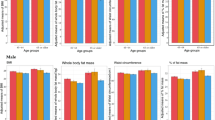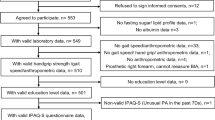Abstract
Background
Sarcopenia is prevalent in ever growing older adult populations.
Aim
The aim of this study was to quantify the association between physical activity (PA), sedentary time (SED), cardiorespiratory fitness (CRF), and strength (STR) with sarcopenia in community-dwelling older adults using a standard definition of sarcopenia.
Method
This cross-sectional study examined a large group of older adults (n = 304) who provided a broad range of health, lifestyle, and socioeconomic variables. PA was assessed using a pedometer worn for 7 days. SED was assessed by survey. CRF was assessed by 400-m walk test performance. Strength (STR) was assessed by one-repetition maximum chest and leg press. The European Working Group on Sarcopenia in Older People (EWGSOP) definition defined 10.9% (n = 33) as sarcopenic.
Results
PA, CRF, and STR were significantly associated with sarcopenia components (muscle mass, muscle strength, and muscle function). The upper two-thirds of CRF had significantly lower odds of having sarcopenia, whereas the strongest third of STR was associated with lower odds of sarcopenia. All exposure variables had significant odds ratios associated with at least one component of sarcopenia. Joint analyses indicated additional benefit may be gained from being both active (≥ 5000 daily steps) and fit (top two-thirds), active and strong (top two-thirds), and fit and strong.
Discussion
Overall, objectively measured PA, CRF, and STR, and self-reported SED, are associated with sarcopenia and its components.
Conclusion
Therefore, older adults who are physically active, maintain higher levels of cardiorespiratory fitness, upper and lower body strength, and avoid sedentary time may have significantly lower odds of sarcopenia.
Similar content being viewed by others
References
Franco MR, Tong A, Howard K et al (2015) Older people’s perspectives on participation in physical activity: a systematic review and thematic synthesis of qualitative literature. Br J Sports Med 49:1268–1276. https://doi.org/10.1136/bjsports-2014-094015
Lee IM, Shiroma EJ, Lobelo F et al (2012) Effect of physical inactivity on major non-communicable diseases worldwide: an analysis of burden of disease and life expectancy. Lancet 380:219–229. https://doi.org/10.1016/S0140-6736(12)61031-9
Paffenbarger RS, Hyde RT, Wing AL, Hsieh CC (1986) Physical activity, all-cause mortality, and longevity of college alumni. N Engl J Med 314:605–613
Franco OH, De Laet C, Peeters A et al (2005) Effects of physical activity on life expectancy with cardiovascular disease. Arch Intern Med 165:2355–2360
Aihie-Sayer A, Dennison EM, Syddall HE et al (2005) Type 2 diabetes, muscle strength, and impaired physical function: the Tip of the iceberg? Diabetes Care 28:2541–2542. https://doi.org/10.2337/diacare.28.10.2541
Cooper R, Kuh D, Cooper C et al (2011) Objective measures of physical capability and subsequent health: a systematic review. Age Ageing 40:14–23. https://doi.org/10.1093/ageing/afq117
Narici MV, Maffulli N (2010) Sarcopenia: characteristics, mechanisms and functional significance. Br Med Bull 95:139–159. https://doi.org/10.1093/bmb/ldq008
De Spiegeleer A, Petrovic M, Boeckxstaens P et al (2016) Treating sarcopenia in clinical practice: where are we now? Acta Clin Belg Int J Clin Lab Med 71:197–205. https://doi.org/10.1080/17843286.2016.1168064
Cruz-Jentoft AJ, Landi F, Schneider SM et al (2014) Prevalence of and interventions for sarcopenia in ageing adults: a systematic review. Report of the International Sarcopenia Initiative (EWGSOP and IWGS). Age Ageing 43:748–759. https://doi.org/10.1093/ageing/afu115
Ethgen O, Beaudart C, Buckinx F et al (2017) The future prevalence of sarcopenia in europe: a claim for public health action. Calcif Tissue Int 100:229–234. https://doi.org/10.1007/s00223-016-0220-9
Shafiee G, Keshtkar A, Soltani A et al (2017) Prevalence of sarcopenia in the world: a systematic review and meta—analysis of general population studies. J Diabetes Metab Disord 16:21. https://doi.org/10.1186/s40200-017-0302-x
Janssen I, Shepard DS, Katzmarzyk PT et al (2004) The healthcare costs of sarcopenia in the United States. J Am Geriatr Soc 52:80–85
Vincent GK, Velkoff VA (2010) The next four decades the older population in the United States: 2010 to 2050 (No. 1138). US Department of Commerce, Economics and Statistics Administration, US Census Bureau, Suitland
Fuggle N, Shaw S, Dennison E et al (2017) Sarcopenia. Best Pract Res Clin Rheumatol 31:218–242. https://doi.org/10.1016/j.berh.2017.11.007
Steffl M, Bohannon RW, Sontakova L et al (2017) Relationship between sarcopenia and physical activity in older people: a systematic review and meta-analysis. Clin Interv Aging 12:835–845. https://doi.org/10.2147/CIA.S132940
Beaudart C, Dawson A, Shaw SC et al (2017) Nutrition and physical activity in the prevention and treatment of sarcopenia: systematic review. Osteoporos Int 28:1817–1833. https://doi.org/10.1007/s00198-017-3980-9
Aggio DA, Sartini C, Papacosta O et al (2016) Cross-sectional associations of objectively measured physical activity and sedentary time with sarcopenia and sarcopenic obesity in older men. Prev Med (Baltim) 91:264–272. https://doi.org/10.1016/j.ypmed.2016.08.040
Rafferty AP, Reeves MJ, McGee HB et al (2002) Physical activity patterns among walkers and compliance with public health recommendations. Med Sci Sports Exerc 34:1255–1261
Steeves JA, Tyo BM, Connolly CP et al (2011) Validity and reliability of the Omron HJ-303 tri-axial accelerometer-based pedometer. J Phys Act Health 8:1014–1020
Tudor-Locke C, Craig CL, Aoyagi Y et al (2011) How many steps/day are enough? For older adults and special populations. Int J Behav Nutr Phys Act 8:80. https://doi.org/10.1186/1479-5868-8-80
Ainsworth BE, Haskell WL, Whitt MC et al (2000) Compendium of physical activities: an update of activity codes and MET intensities. Med Sci Sports Exerc 32:S498–S516
Craig CL, Marshall AL, Sjöström M et al (2003) International physical activity questionnaire: 12-country reliability and validity. Med Sci Sports Exerc 35:1381–1395. https://doi.org/10.1249/01.MSS.0000078924.61453.FB
Seguin R, Buchner DM, Liu J et al (2014) Sedentary behavior and mortality in older women: the women’s health initiative. Am J Prev Med 46:122–135. https://doi.org/10.1016/j.amepre.2013.10.021
Pavey TG, Peeters G(Geeske), Brown WJ (2015) Sitting-time and 9-year all-cause mortality in older women. Br J Sports Med 49:95–99. https://doi.org/10.1136/bjsports-2012-091676
van der Ploeg H, Chey T, Korda R et al (2012) Sitting time and all cause mortality risk in 222,497 Australian adults. Arch Intern Med 172:494–500. https://doi.org/10.1007/s13398-014-0173-7.2
Pahor M, Guralnik JM, Ambrosius WT et al (2014) Effect of structured physical activity on prevention of major mobility disability in older adults: the LIFE study randomized clinical trial. JAMA—J Am Med Assoc 311:2387–2396. https://doi.org/10.1001/jama.2014.5616
Deshpande N, Metter EJ, Guralnik J et al (2013) Predicting 3-year incident mobility disability in middle-aged and older adults using physical performance tests. Arch Phys Med Rehabil 94:994–997. https://doi.org/10.1016/j.apmr.2012.10.032
American College of Sports Medicine (2013) ACSM’s guidelines for exercise testing and prescription, 9th edn. Wolters Kluwer/Lippincott Williams & Wilkins Health, Philadelphia
Artero EG, Lee DC, Ruiz JR et al (2011) A prospective study of muscular strength and all-cause mortality in men with hypertension. J Am Coll Cardiol 57:1831–1837. https://doi.org/10.1016/j.jacc.2010.12.025
Ruiz JR, Sui X, Lobelo F et al (2008) Association between muscular strength and mortality in men: prospective cohort study. Br Med J 337:a439. https://doi.org/10.1136/bmj.a439
Guralnik JM, Ferrucci L, Simonsick EM et al (1995) Lower-extremity function in persons over the age of 70 years as a predictor of subsequent disability. N Engl J Med 332:556–561. https://doi.org/10.1056/NEJM199503023320902
Bijlsma AY, Meskers CGM, Ling CHY et al (2013) Defining sarcopenia: the impact of different diagnostic criteria on the prevalence of sarcopenia in a large middle aged cohort. Age (Omaha) 35:871–881. https://doi.org/10.1007/s11357-012-9384-z
Sousa AS, Guerra RS, Fonseca I et al (2015) Sarcopenia among hospitalized patients—a cross-sectional study. Clin Nutr 34:1239–1244. https://doi.org/10.1016/j.clnu.2014.12.015
Fielding RA, Vellas B, Evans WJ et al (2011) Sarcopenia: an undiagnosed condition in older adults. current consensus definition: prevalence, etiology, and consequences. International Working Group on Sarcopenia. J Am Med Dir Assoc 12:249–256. https://doi.org/10.1016/j.jamda.2011.01.003
Studenski SA, Peters KW, Alley DE et al (2014) The FNIH sarcopenia project: rationale, study description, conference recommendations, and final estimates. J Gerontol A Biol Sci Med Sci 69:547–558. https://doi.org/10.1093/gerona/glu010
Shaffer NC, Ferrucci L, Shardell M et al (2017) Agreement and predictive validity using less conservative FNIH sarcopenia project weakness cutpoints. J Am Geriatr Soc 65:574–579. https://doi.org/10.1016/S0140-6736(14)62286-8.Liberal
Beaudart C, Zaaria M, Oise Pasleau F et al (2017) Health outcomes of sarcopenia: a systematic review and meta-analysis. PLoS ONE 12:1–16. https://doi.org/10.1371/journal.pone.0169548
Kelley GA, Kelley KS (2017) Is sarcopenia associated with an increased risk of all-cause mortality and functional disability? Exp Gerontol 96:100–103. https://doi.org/10.1016/j.exger.2017.06.008
Sheikh JI, Yesavage JA (1986) Geriatric Depression Scale (GDS): recent evidence and development of a shorter version. Clin Gerontol 5:165–173
Hays RD, Sherbourne CD, Mazel RM (1993) The RAND 36-item health survey 1.0. Health Econ 2:217–227. https://doi.org/10.1002/hec.4730020305
Bouchery EE, Harwood HJ, Sacks JJ et al (2011) Economic costs of excessive alcohol consumption in the U.S., 2006. Am J Prev Med 41:516–524. https://doi.org/10.1016/j.amepre.2011.06.045
Studenski S, Perera S, Patel K (2011) Gait speed and survival in older adults. J Am Med Assoc 305:50–58. https://doi.org/10.1001/jama.2010.1923.Gait
Peel NM, Kuys SS, Klein K (2012) Gait speed as a measure in geriatric assessment in clinical settings: a systematic review. J Gerontol 68:39–46. https://doi.org/10.1093/gerona/gls174
Westbury LD, Dodds RM, Syddall HE et al (2018) Associations between objectively measured physical activity, body composition and sarcopenia: findings from the Hertfordshire Sarcopenia Study (HSS). Calcif Tissue Int. https://doi.org/10.1007/s00223-018-0413-5
Pedrero-Chamizo R, Gomez-Cabello A, Melendez A et al (2015) Higher levels of physical fitness are associated with a reduced risk of suffering sarcopenic obesity and better perceived health among the elderly: the EXERNET multi-center study. J Nutr Health Aging 19:211–217. https://doi.org/10.1007/s12603-014-0530-4
Chien M, Kuo H, Wu Y (2010) Sarcopenia, cardiopulmonary fitness, and physical disability in community-dwelling elderly people. Phys Ther 90:1277–1287
Bell KE, Von Allmen MT, Devries MC et al (2016) Muscle disuse as a pivotal problem in sarcopenia-related muscle loss and dysfunction. J Frailty Aging 5:33–41
Hvid LG, Suetta C, Nielsen JH et al (2014) Aging impairs the recovery in mechanical muscle function following 4 days of disuse. Exp Gerontol 52:1–8. https://doi.org/10.1016/j.exger.2014.01.012
Breen L, Stokes KA, Churchward-Venne TA et al (2013) Two weeks of reduced activity decreases leg lean mass and induces “anabolic resistance” of myofibrillar protein synthesis in healthy elderly. J Clin Endocrinol Metab 98:2604–2612. https://doi.org/10.1210/jc.2013-1502
Demakakos P, Hamer M, Stamatakis E et al (2010) Low-intensity physical activity is associated with reduced risk of incident type 2 diabetes in older adults: evidence from the English Longitudinal Study of Ageing. Diabetologia 53:1877–1885. https://doi.org/10.1007/s00125-010-1785-x
Funding
This study was supported by an unrestricted research grant from Biospace. The content is solely the responsibility of the authors and does not necessarily represent the official views of Biospace.
Author information
Authors and Affiliations
Corresponding author
Ethics declarations
Conflict of interest
The authors declare no they have no conflict of interest and are solely responsible for the content and writing of this article.
Statement of human and animal rights
All procedures performed in studies involving human participants were in accordance with the ethical standards of the institutional and/or national research committee (the Institutional Review Board of Iowa State University, IRB # 15-430) and with the 1964 Helsinki Declaration and its later amendments or comparable ethical standards.
Informed consent
Informed consent was obtained from all individual participants included in the study.
Additional information
Publisher's Note
Springer Nature remains neutral with regard to jurisdictional claims in published maps and institutional affiliations.
Rights and permissions
About this article
Cite this article
Meier, N.F., Lee, Dc. Physical activity and sarcopenia in older adults. Aging Clin Exp Res 32, 1675–1687 (2020). https://doi.org/10.1007/s40520-019-01371-8
Received:
Accepted:
Published:
Issue Date:
DOI: https://doi.org/10.1007/s40520-019-01371-8




